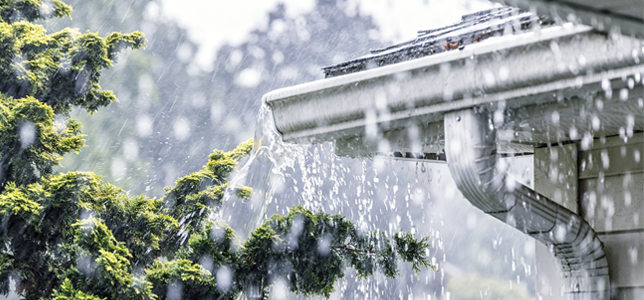Attention: You need JavaScript enabled to use this site.
In the UK, insurance companies typically receive the most home insurance claims caused by bad weather in the first three months of the year. And if you live in the country, you’ll understand why. Our weather can be unpredictable – from snow to thunder and lightning – so being proactive and preparing your home in advance can be critical.
This useful guide will take you through the steps to prepare your home ahead of storm season, including what to do before, during and after a storm.

Storms can be defined as a period of bad or aggressive weather, usually with high wind speeds, heavy rainfall, snowfall, or hail showers.
The Beaufort wind force scale is used in marine forecasts and measure wind intensity based on observed sea conditions. There is a total of 12 scales (with 12 being the highest), and each scale has a slightly different intensity of storm factors:
In the UK, we name our storms that are due to have a detrimental effect to cities and towns across the country. The reason we give them names is so that there is better communication of what’s to come through the media and government agencies. This better informs us of how to prepare our homes and belongings.
Usually, we first hear about a storm approaching through the media – on the news online or on social media, on the TV or via the radio. There’s typically a bit of notice so that we’ve got time to get prepared. It’s worth noting that doing checks every now and then on your home and belongings would eliminate any rush or panic to get things ready specifically for a storm. When adverse weather is predicted, the BBC issue frequent weather warnings.
Here are some top tips for preparing your home for a storm, or for general maintenance ahead of storm season.
Pruning or cutting back your trees is one of the main items of preparation. Branches can easily snap or break off in a storm. They can drop or be carried in wind and cause significant damage to your home or belongings. Weak points of a tree will always be affected first, so your general maintenance checks can include checking for these frail areas. Remove any that you don’t think look strong enough to survive a storm.
If the weak areas of the tree are too big or tricky to manage yourself, you might need to enlist the help of a tree specialist. Remember: using machinery or climbing ladders can cause serious injury.
Fences can bear the brunt of a storm, so it can be a good idea to repair or strengthen yours ahead of a storm. If you’re installing a new fence, it’s worth researching the best type of fence panel to withstand high winds. They can also be torn from their base in the ground if they’re not firmly rooted.
Clear weeds and rubbish away from the fence panels. Make sure there’s adequate drainage around to prevent the base of your fence from getting waterlogged, as wood posts can rot if they’re not maintained properly. Minor damage can be patched up with spare wood and nails, and during warmer months a fence preservative could be applied to help protect the wood.
Big pieces of outdoor furniture can be affected by storms just as much as smaller items such as plant pots. It’s a good idea to secure larger items, such as tables, chairs, and trampolines, that may be picked up or knocked over in wind. It might also be worth covering or protecting certain items that could get damaged by heavy rain or hail. Smaller pieces may need to be secured or brought inside too, such as lights, potted plants, toys, and ornaments.
Checking your roof ahead of storm season can be critical to prevent extensive damage during or after a storm. Some things to check include:
If you’re unsure or can’t get access safely to your roof, it might be worth enlisting the help of a roof specialist.
It’s worth making these checks as part of your general year-round maintenance. If professional work is required, it can be costly or take a lot of time, so spotting issues before they become problematic could save money in the long term. If fixes aren’t put in place in advance, then a storm could cause further damage to your home.
It can be common for there to be weak spots around your chimney and vents, so make sure to check in and around these. Again, it’s worth adding this to your list of year-round general maintenance. Some things to check include:
It's worth noting here that checking your chimney can be a dangerous task, so seeking the help of a professional may be worth looking into if you are unsure or unable to complete checks yourself safely.
Blockages can be caused year-round to guttering and drains, especially from natural occurrences such as leaf fall and moss build up. It’s worth checking year-round to make sure there are no areas of concern. Always try to rectify any breakage or damage well in advance of storm season.
Joints should be checked to make sure there are no leaks, and that they’re strong enough to withstand adverse weather conditions. If damage is left unrepaired, it can cause further harm such as weakened walls, water damage inside your home, and general roof failure.
If possible, moving your car away from areas of potential damage could be a good idea ahead of a storm. If you have a garage or a car port, it would be worth utilising it for your car for the duration of the storm. After all, damage to your car could be costly to fix. Some things to consider moving your car away from are:
Unstable fenceposts or poles.
It’s worth considering your home insurance options ahead of the winter season.
You can also get familiar with what’s covered, renew your policy, and check all your details are up to date and accurate. While we don’t cover fences, gates and hedges against storm damage, it’s worth checking what we do cover.
Storms can be a worrying time for us, but here are some tips for what you might want to do while the weather is bad outside.
It might not be wise to head outside during a bad storm, so having an emergency kit to hand in case anything goes wrong can be a good idea. This will, of course, depend on the severity of the storm. An emergency kit could be useful if a severe storm is occurring, however you may not need to reach for a kit in the event of a light storm, such as thunder and lightning or moderate to heavy rainfall.
It’s worth considering all eventualities such as your electric supply cutting out or contacting someone for help. Some items to have to hand might include:
You also might want to have some indoor activities ready for all the family while you’re sitting out the storm – board games, card games, or even some colouring in.
If your home is prone to flooding, lay some sandbags outside doors and windows ahead of time, and check they remain in place during a storm to prevent any water getting in.
Buckets and bowls may come in handy, in case you need to catch a leaky roof or tip water out that has come inside. Keeping up to date with the Environment Agency (and signing up for flood alerts) can help you prepare for different eventualities and can also help you to track the progress of the storm.
The storm has passed, and now you’re checking for any damage occurred. We’ve put together some tips of what to check and how.
It could be wise to think about carefully and safely checking your home and belongings for any damage that may have been caused by a storm. This can include:
Make a note of any damage and think about whether it’s something you need to submit a home insurance claim for. Some of these checks could be dangerous. If you’re unsure, enlist the help of a trade specialist who can survey damage in detail and give professional advice.
If you spot any damage to your home, it’s best to follow up on this promptly to avoid further risk, and also to get any necessary claims underway. We can’t control the weather, but we can be prepared for adverse conditions.
Click here to apply or read more about the home insurance available from the West Brom
